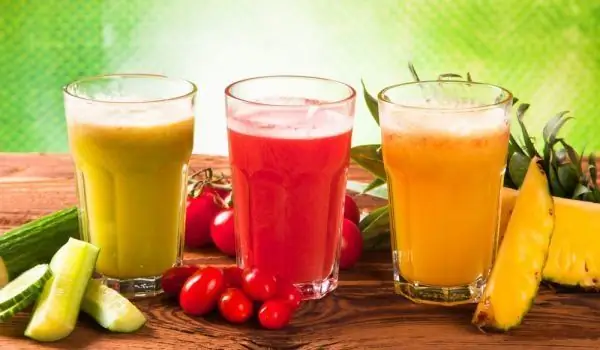2025 Author: Jasmine Walkman | [email protected]. Last modified: 2025-01-23 10:18
Surely you have heard the loud advertisements of various manufacturers who claim that a glass of natural juice a day is equal to a portion of fresh fruits or vegetables. There is, of course, no truth in this.
The famous natural fruit juice in cardboard boxes has nothing to do with a natural drink, tests show, as well as the discovery of production technology. However, the Bulgarian consumer continues to buy it en masse, and lately still emphasizes the packaging with the inscription 100%, thinking that we are talking about one hundred percent juice.
Most natural juices contain a huge amount of sugar, and those without sugar - even more harmful artificial sweeteners. Experts have found that 200-250 ml of juice can contain up to 6-7 teaspoons of sugar.
In a publication in the journal Lancet Diabetes and Endocrinology, researchers compared the nutritional value of apple juice with that of a box of cola. One glass of apple juice contains 110 calories and 26 grams of sugar. The amount of calories and sugar are almost identical to those you will find in the same volume of soda, they conclude.

These drinks are full of many chemical substances to be stored for a long time, to have a good color, taste and aroma. Colorants, enhancers, flavors, preservatives - probably in the box with natural juice there is almost no real juice.
A real nightmare pops up if one gets acquainted with the technological process in the production of fruit juices. Experts warn: 100% natural does not mean that there is nothing in the box but fruit juice. One hundred percent natural juice is made from 80% water and 20% concentrate.
The concentrate is from the lowest quality fruits, as the juice goes for other purposes, and the remaining squeezed peels and the already almost completely dry inside - the pulp, are ground to a puree. It is frozen and stored and after a while - maybe a few years - the frozen semi-finished product finds a buyer - a producer of soft drinks. It thaws the slurry concentrate, dilutes it with water in a ratio of 1 to 4.
The newly obtained liquid smells somewhat of the original fruit, but it is not fruity enough. Therefore, treatment with a bunch of E's for flavor, color, etc. follows. Sugar or sweetener is added and the natural juice is ready.
Recommended:
Freshly Squeezed Juices Can Be Insidious

Extremely tasty and refreshing freshly squeezed juices and fresh juices are not a pleasure that everyone can afford. It is true that most of them are extremely useful for one or another condition of the body, but for certain diseases can be quite harmful.
Pros And Cons Of Natural Juices In Cans

There is hardly a person who has not watched at least one ad on natural juices . Manufacturers are vying to convince consumers that their products are very healthy and vitamin-rich. But is that really so? In general, everyone is aware that fruits are an extremely important part of the food pyramid.
How Natural Are Natural Products?

You go to the hypermarket and buy your favorite natural yogurt to eat with the natural healthy breakfast. You pay for them an idea more expensive, because, after all, they are natural! They are not like the rest of the junk of the food industry, which is full of preservatives, dyes and all kinds of E's.
Are Natural Juices Useful?

For many people, the use of fruit juices is part of a healthier lifestyle. It is widely believed that the juice is a natural and useful product that can be consumed without restriction. Many even believe that fruit drinks are an integral part of any diet for weight loss because of the fruit content in them.
Rules For The Preparation Of Raw Natural Fruit And Vegetable Juices

There is absolutely nothing complicated in the preparation of home-made fruit and vegetable drinks, especially in the preparation of raw fruit drinks. It takes literally a few minutes, as long as you have the necessary equipment and raw materials.

